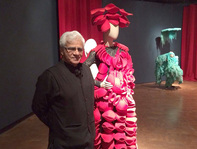
LOS ANGELES, CA - Making Strange: Gagawaka + Postmortem by Vivan Sundaram is organized by the Fowler Museum at the University of California Los Angeles (UCLA). The exhibition is open until Sept 6 .Making Strange brings together two striking bodies of work by Delhi-based contemporary artist Vivan Sundaram, founding member of the Sahmat Collective and one of the leading artists working in India today.

The first project, Gagawaka, is comprised of twenty-seven sculptural garments made from recycled materials and medical supplies to evoke a playful yet subversive relationship to fashion, haute couture, the runway, and the brand. Gagawaka represents Sundaram’s own fictional brand and line of “strange” haute couture with highly inventive garments fabricated out of foam cups, surgical masks, x-ray-film, hospital bandages, foil pill wrappings, and more. The invented word has pop-culture references to Lady Gaga and the 2010 World Cup anthem Waka Waka. Gagawaka is presented in dialog with Postmortem, a collection of haunting sculptural objects comprised of mannequins, tailor’s dummies, wooden props, and anatomical models. Postmortem questions the spectacle of Gagawaka with a wider set of commentaries about the human body and social concerns related to aging and illness. These two projects by Sundaram are being presented together for the first time in North America.
Making Strange is being presented in the Fowler’s 5,700 square-foot Getty Gallery within a highly theatrical setting sympathetic to the fashion spectacle of Gagawaka. For Sundaram, the juxtaposition of Gagawaka and . Postmortem should not be viewed “as if one follows the other, or that Postmortem is destroying or dismantling everything that was in Gagawaka.“ To the contrary, Sundaram states, it reveals a “constant shifting of different meanings that informs a lot of my work and I hope this becomes apparent in the spirit of holding these shows together.”
According to co-curator Saloni Mathur, “when one thinks of the dialog between fashion and health, countless conditions of global crises come to mind, for instance, the entanglement between the sweatshop and the brand, the testing of pharmaceuticals in developing nations, and the environmental impact of biomedical waste.” In the face of these unsettling social conditions, “Sundaram’s work invites us into a world that may well be in fragments, but that is resilient and finds its means to repair by returning to elemental functions and discarded forms.”
The Fowler is also presenting a related exhibition‘ The Sahmat Collective: Art and Activism in India since 1989’ which is running through August 2. It features works from over 60 Sahmat artists including founding member Vivan Sundaram. Since 1989, the Delhi-based Sahmat collective has given artists, writers, poets, musicians, and actors a platform to create and present works of art that promote artistic freedom and celebrate secular, egalitarian values
Making Strange is being presented in the Fowler’s 5,700 square-foot Getty Gallery within a highly theatrical setting sympathetic to the fashion spectacle of Gagawaka. For Sundaram, the juxtaposition of Gagawaka and . Postmortem should not be viewed “as if one follows the other, or that Postmortem is destroying or dismantling everything that was in Gagawaka.“ To the contrary, Sundaram states, it reveals a “constant shifting of different meanings that informs a lot of my work and I hope this becomes apparent in the spirit of holding these shows together.”
According to co-curator Saloni Mathur, “when one thinks of the dialog between fashion and health, countless conditions of global crises come to mind, for instance, the entanglement between the sweatshop and the brand, the testing of pharmaceuticals in developing nations, and the environmental impact of biomedical waste.” In the face of these unsettling social conditions, “Sundaram’s work invites us into a world that may well be in fragments, but that is resilient and finds its means to repair by returning to elemental functions and discarded forms.”
The Fowler is also presenting a related exhibition‘ The Sahmat Collective: Art and Activism in India since 1989’ which is running through August 2. It features works from over 60 Sahmat artists including founding member Vivan Sundaram. Since 1989, the Delhi-based Sahmat collective has given artists, writers, poets, musicians, and actors a platform to create and present works of art that promote artistic freedom and celebrate secular, egalitarian values

 RSS Feed
RSS Feed
